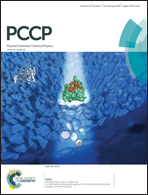Chemical vs. electrochemical extraction of lithium from the Li-excess Li1.10Mn1.90O4 spinel followed by NMR and DRX techniques
Abstract
Lithium extraction from the Li-excess Li1.10Mn1.90O4 spinel has been performed by chemical and electrochemical methods in aqueous and in organic media, respectively. De-lithiated samples have been investigated by XRD, SEM, TG, 7Li and 1H MAS-NMR techniques. The comparative study has allowed demonstrating that the intermediate de-intercalated samples prepared during the chemical extraction by acid titration are similar to those prepared by the electrochemical way in a non-aqueous electrolyte. LiMn2O4 based spinel with a tailored de-lithiation degree can be prepared as a single phase by controlling the pH used in chemical extraction. 7Li MAS-NMR spectroscopy has been used to follow the influence of the manganese oxidation state on tetra and octahedral Li-signals detected in Li-extracted samples. The oxidation of Mn(III) ions goes parallel to the partial dissolution of the spinel, following Hunter's mechanism. Based on this mechanism, a generalized chemical reaction has been proposed to explain the formation of intermediate Li+ de-intercalated samples during acid treatment in aqueous media. By the 1H MAS NMR study, no evidence of Li–H topotactic exchange in the bulk of the acid treated material was found.


 Please wait while we load your content...
Please wait while we load your content...